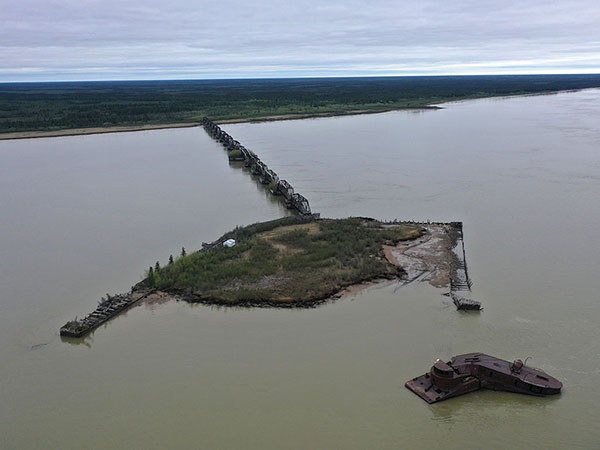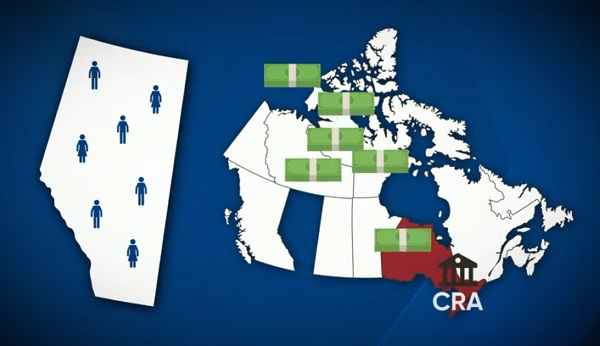Alberta
MB/SK/AB NeeStaNan Utilities Corridor: First Nations-led utility corridor is a 21st-century nation-building initiative

Port Nelson is 300 kilometres south of Churchill and has a longer ice-free season. In fact, a concrete jetty constructed (and never used) at Port Nelson nearly a hundred years ago remains in place.
From the Frontier Centre for Public Policy
By Terry Etam
“The trading of goods has been in our DNA as Indigenous People for centuries, but somewhere along the way this was lost. It’s time to regain our prosperity, for the betterment of our communities and for our country.” – NeeStaNan website
Ever feel like you’re being neglected by either governments or the various power centers that dominate life? The big places get all the attention, have all the votes, have all the buzz. In Canada, fewer than ten such centers dominate the country. If you’re not in one of those, you won’t know much political power, there won’t be much clout, there won’t be much of anything.
And if you want to know how far you can get from a circle of influence, consider Census Division No. 23, a great big administrative district in northern Manitoba. The size and ruggedness are mindboggling; No. 23 encompasses an area of 233,578 square km/90,185 square miles, six times the area of Switzerland, yet the region’s total population is 4,690. The population density, rounded to the nearest person-per-square km, is zero. If you round it to the nearest tenth of a square km, it is still zero.
It is extremely hard for people of regions like this to register on the national radar for any number of reasons, some of which are just logistical (remote location) and some of which are just rude realities (not much political capital up for grabs in No. 23).29dk2902l
The people of regions like this tend to be absent from all sorts of things, including resource development, even if it happens in these regions. Yes, there will be some local employment, and positive economic spinoffs, but nothing in the way of meaningful ownership or control.
But that may be about to change, for a significant swath of Manitoba, Saskatchewan, and the northeastern part of Alberta. Underway is the NeeStaNan utility corridor, stretching from northern Alberta through north-central Saskatchewan and on to the shores of Hudson Bay in Manitoba.
The significance of this corridor could be profound. It will provide tidewater access for landlocked western Canadian resources that otherwise need to travel to the west coast, or other less efficient routes. As one of the best examples, Saskatchewan must move potash to market via Vancouver, meaning a trip through the Rocky Mountains and on to the coast.
By utilizing the NeeStaNan utility corridor, potash will be able to move to large markets like Brazil far more efficiently. The distance to seawater via Hudson Bay is 630 km/390 miles less than by going through BC ports, and here’s the real economic kicker: the sea route to Brazil’s market is actually 3,800 km less than current routes. That’s almost 2,400 miles, for American friends and for old times’ sake.
The corridor is planned to enter Hudson Bay not at Churchill, but at a much more direct and accessible point called Port Nelson. Port Nelson is some 300 kilometres/180 miles south of Churchill (Hudson Bay is really freaking big) and has a longer ice-free season. In fact, a concrete jetty constructed (and never used) at Port Nelson nearly a hundred years ago remains in place. Port Nelson isn’t a new idea.
The utility corridor isn’t simply a project to enhance the wellbeing of the FN bands along the way, although it will most certainly do that. It is also far more grand in scope: the utility corridor will help Canada’s heartland deliver industrial products to global markets in a more efficient way, and provide the sort of efficiencies that can help multiple Canadian industries enhance global competitiveness, all the while providing an economic boost that is infinitely better than what locals and First Nations along the way have ever known.
Many industries could benefit, including the oil and gas sector, and I’m going to say that now before any legislation passes that makes it illegal. There is potential to utilize the corridor to move rail cargoes, pipelines, lumber, agricultural products, raw materials, manufactured goods… an endless array of the stuff that makes Canada wealthy.
The project is enormously captivating right from its very name. “NeeStaNan” translates as “all of us”. How cool is that; inclusiveness not under the guise some overwrought mandate, but in the sense that the project is being structured to benefit a great number of parties. The home page of the NeeStaNan website describes the project as a utility corridor “uniting Canadians”. Now, doesn’t that phrase sound far more powerful coming from the heartland, from people with skin in the game, as opposed to insincere platitudes thrown about like confetti on the campaign trail?
The utility corridor really could unite Canadians; it is a slingshot of vitality into Canada’s industrial base. It could benefit many critical industries, and open up new trade possibilities. It is a project designed to bring in many First Nations along the route that have very little to show for Canada’s development. It’s not a handout, it’s the opposite – a benefit to Canada and a great many Canadians.
Isn’t this what First Nations Self Determination should be about? Isn’t this a perfect dovetail with the interests of the people who live in these remote areas, who are the only ones there, and who deserve a say in how it is developed? Isn’t it amazing that it is a collaborative effort that by design will benefit industries that these First Nations have no direct stake in?
Isn’t it the best possible goal and achievement of all the efforts to bring First Nations fully into the Canadian matrix on a way that works for everyone, and that benefits everyone?
And who would be better than First Nations along the corridor’s path as the stewards of the corridor itself? Who knows the terrain better? I’ve been there, I grew up not in the path of the corridor but I could see it from a north facing window, and I’ll tell you it’s not territory for the faint of heart. Winters are brutal and long, summers are hot and buggy, and nature is relentless. Local expertise and wisdom would be invaluable.
I can’t really think of an infrastructure project of the past fifty years that could have such multi-dimensional benefits to so many Canadians. It is uplifting to see collaboration across many First Nations and the governments of three provinces. Ottawa may not like it, because the corridor is sure to empower an area of the country that has few votes to harvest, but that is all the more reason to get behind and support the project’s owners, organizers, and operators.
The NeeStaNan utility corridor might do more for a forgotten region of Canada, and its First Nations, than 150 years of federal government “help”. Let’s hope all three prairie provinces and the First Nations along the way bring the corridor into life and to its full potential.
Terry Etam is a columnist with the BOE Report, a leading energy industry newsletter based in Calgary. He is the author of The End of Fossil Fuel Insanity. You can watch his Policy on the Frontier session from May 5, 2022 here.
Alberta
Alberta Next: Taxation

A new video from the Alberta Next panel looks at whether Alberta should stop relying on Ottawa to collect our provincial income taxes. Quebec already does it, and Alberta already collects corporate taxes directly. Doing the same for personal income taxes could mean better tax policy, thousands of new jobs, and less federal interference. But it would take time, cost money, and require building new systems from the ground up.
Alberta
Cross-Canada NGL corridor will stretch from B.C. to Ontario

Keyera Corp.’s natural gas liquids facilities in Fort Saskatchewan. Photo courtesy Keyera Corp.
From the Canadian Energy Centre
By Will Gibson
Keyera ‘Canadianizes’ natural gas liquids with $5.15 billion acquisition
Sarnia, Ont., which sits on the southern tip of Lake Huron and peers across the St. Clair River to Michigan, is a crucial energy hub for much of the eastern half of Canada and parts of the United States.
With more than 60 industrial facilities including refineries and chemical plants that produce everything from petroleum, resins, synthetic rubber, plastics, lubricants, paint, cosmetics and food additives in the southwestern Ontario city, Mayor Mike Bradley admits the ongoing dialogue about tariffs with Canada’s southern neighbour hits close to home.
So Bradley welcomed the announcement that Calgary-based Keyera Corp. will acquire the majority of Plains American Pipelines LLP’s Canadian natural gas liquids (NGL) business, creating a cross-Canada NGL corridor that includes a storage hub in Sarnia.
“As a border city, we’ve been on the frontline of the tariff wars, so we support anything that helps enhance Canadian sovereignty and jobs,” says the long-time mayor, who was first elected in 1988.
The assets in Sarnia are a key piece of the $5.15 billion transaction, which will connect natural gas liquids from the growing Montney and Duvernay plays in B.C. and Alberta to markets in central Canada and the eastern U.S. seaboard.
NGLs are hydrocarbons found within natural gas streams including ethane, propane and pentanes. They are important energy sources and used to produce a wide range of everyday items, from plastics and clothing to fuels.
Keyera CEO Dean Setoguchi cast the proposed acquisition as an act of repatriation.
“This transaction brings key NGL infrastructure under Canadian ownership, enhancing domestic energy capabilities and reinforcing Canada’s economic resilience by keeping value and decision-making closer to home,” Setoguchi told analysts in a June 17 call.
“Plains’ portfolio forms a fully integrated cross Canada NGL system connecting Western Canada supply to key demand centres across the Prairie provinces, Ontario and eastern U.S.,” he said.
“The system includes strategic hubs like Empress, Fort Saskatchewan and Sarnia – which provide a reliable source of Canadian NGL supply to extensive fractionation, storage, pipeline and logistics infrastructure.”
Martin King, RBN Energy’s managing director of North America Energy Market Analysis, sees Keyera’s ability to “Canadianize” its NGL infrastructure as improving the company’s growth prospects.
“It allows them to tap into the Duvernay and Montney, which are the fastest growing NGL plays in North America and gives them some key assets throughout the country,” said the Calgary-based analyst.
“The crown assets are probably the straddle plants in Empress, which help strip out the butane, ethane and other liquids for condensate. It also positions them well to serve the eastern half of the country.”
And that’s something welcomed in Sarnia.
“Having a Canadian source for natural gas would be our preference so we see Keyera’s acquisition as strengthening our region as an energy hub,” Bradley said.
“We are optimistic this will be good for our region in the long run.”
The acquisition is expected to close in the first quarter of 2026, pending regulatory approvals.
Meanwhile, the governments of Ontario and Alberta are joining forces to strengthen the economies of both regions, and the country, by advancing major infrastructure projects including pipelines, ports and rail.
A joint feasibility study is expected this year on how to move major private sector-led investments forward.
-

 Business1 day ago
Business1 day agoCarney government should apply lessons from 1990s in spending review
-

 Business1 day ago
Business1 day agoTrump to impose 30% tariff on EU, Mexico
-

 illegal immigration1 day ago
illegal immigration1 day agoICE raids California pot farm, uncovers illegal aliens and child labor
-

 Entertainment24 hours ago
Entertainment24 hours agoStudy finds 99% of late-night TV guests in 2025 have been liberal
-

 Business2 days ago
Business2 days ago103 Conflicts and Counting Unprecedented Ethics Web of Prime Minister Mark Carney
-

 Energy1 day ago
Energy1 day agoLNG Export Marks Beginning Of Canadian Energy Independence
-

 Frontier Centre for Public Policy13 hours ago
Frontier Centre for Public Policy13 hours agoCanada’s New Border Bill Spies On You, Not The Bad Guys
-

 Uncategorized12 hours ago
Uncategorized12 hours agoCNN’s Shock Climate Polling Data Reinforces Trump’s Energy Agenda




